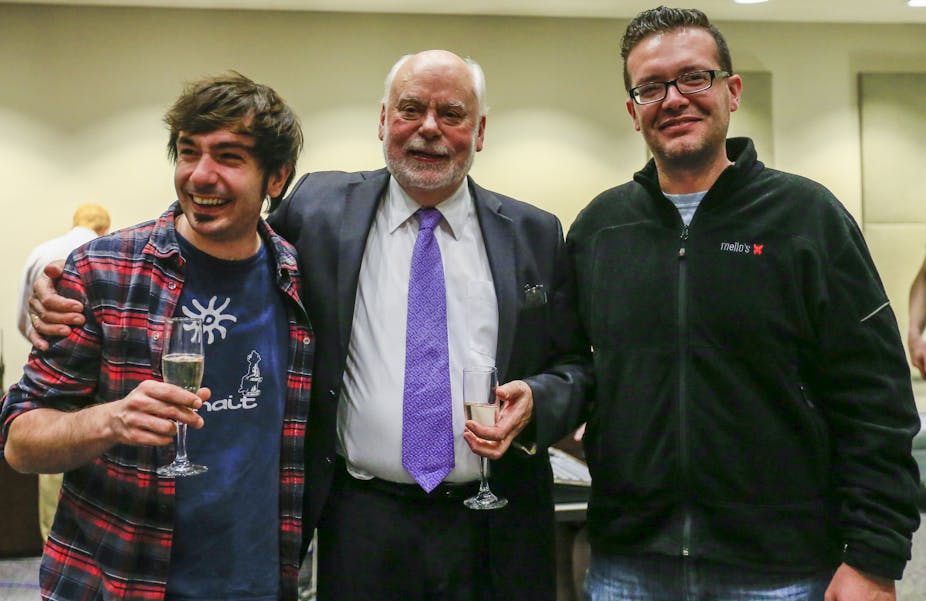Fraser Stoddart was awarded this year’s Nobel Prize in Chemistry jointly with Jean-Pierre Sauvage and Bernard Feringa “for the design and synthesis of molecular machines”. Stoddart is currently professor of chemistry at Northwestern University, Illinois. But he was born in Edinburgh and went to university there, then taking up a postdoctoral position in Ontario before returning to the UK as an academic, initially at Sheffield University and then at the University of Birmingham.
It was at Birmingham, as a professor of organic chemistry from 1990 until 1997, that Stoddart published key work cited in the award, such as the first molecular rotaxane – an organic ring structure threaded on an axle. Within three years he had worked out how to transform this into a controllable molecular machine that could switch the ring structure back and forth along the axle between two molecular docking points.
The genius of Stoddart and his co-winners is that they were able to see that the natural world, in particular biology, is replete with examples of molecular machines. Enzymes, for example, capture biological molecules, in order to perform chemical transformations, before releasing them. They had the vision to understand how nature’s functioning molecular machines, and translate this understanding into designing and actually making non-biological machines with non-biological functions.
Jon’s time with Stoddart
One of us (Jon Preece) was fortunate enough to do his doctoral research under the supervision of Stoddart. He was, and still is, a man of tremendous vision for the future of chemistry, and what its impact might be on society. In his group it was clear he had an infectious enthusiasm for science, and allowed and encouraged free thinking and the exploration of ideas. It was a remarkably stimulating and – dare I say it – a fun place to be in the 1990s. He quite simply was, and still is, an inspiration to the numerous young scientists who have been lucky enough to be part of the Stoddart family, which amazingly spans five decades of highly productive and groundbreaking research.
An integral part of Stoddart’s life at the time was his late wife Norma, who in addition to being a mother to their two daughters, and organiser of Stoddart’s professional and personal life, was also a friend, mentor, adviser and sometimes surrogate mother to the young researchers in the group. She really played a central role in the successes of the group. She sadly passed away in 2004, but is fondly remembered by everyone.

As you might imagine when it comes to science Stoddart is intense, has an eye for detail and is very particular about how things should be done. This was both exasperating and a great learning experience, in equal measure. At least that’s what I recall as a young PhD student, having my manuscript red-penned by him for the umpteenth time, or him interrogating my work and asking me probing questions. These are lessons that I have taken with me to this very day, and use it to “terrorise” my own students.
Outside of work Stoddart and his wife were extraordinarily generous and fun to know. As a group we had many parties at the Stoddart house or at local pubs to celebrate successful PhD vivas, birthdays and the like. Norma would put on some Scottish music and drag Soddart up to do a highland dance together. Surprisingly he was quite nimble – a quality which he would occasionally use on the football pitch with the group on a Friday evening.
After receiving the prize, Stoddart was quite outspoken about his views on how Brexit will affect science: “I am very disturbed by the talk coming out of the UK at the moment … Anything that stops the free movement of people is a big negative for science.” This was not surprising – he was never afraid to air his views, especially on issues that have a direct effect on science.
It is fitting to reflect upon one of the Stoddart group’s celebrated achievements at Birmingham and widely reported, which was the synthesis of Olympiadane in 1994, a molecule formed from five interlocking molecular rings.
In an Olympic Year, then, it is fitting that the creator of this molecule became a Nobel laureate, science’s equivalent of an Olympic gold medal.

